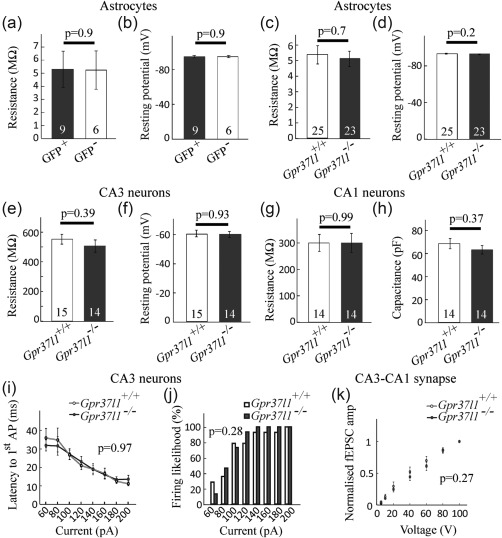Figure 4.

Resting electrical properties of astrocytes and neurons are not affected by Gpr37l1 expression. (a, b) Astrocytes expressing or lacking GFP in hippocampal slices from the Gfp37l1‐GFP mouse have similar (a) membrane resistance, and (b) resting potential (number of cells on bars). Astrocytes in hippocampal slices from wild type and Gpr37l1 knock‐out mice have similar (c) membrane resistance and (d) resting potential. (e, f) CA3 pyramidal cells in hippocampal slices from wild type and Gpr37l1 knock‐out mice have similar (e) membrane resistance and (f) resting potential. (g, h) CA1 pyramidal cells in hippocampal slices from wild type and Gpr37l1 knock‐out mice have similar (g) membrane resistance and (h) capacitance (used to normalise drug‐evoked currents in Figure 5; resting potential was not studied as the internal solution contained Cs+). (i, j) Excitability of CA3 neurons in slices from wild type and Gpr37l1 knock‐out mice. (i) Latency to first action potential as a function of current injected into CA3 pyramidal neurons (Gpr37l1 +/+ n = 15, Gpr37l1 –/– n = 15). (j) Percentage of responses in (i) that showed action potentials as a function of injected current. (k) Field EPSCs evoked in area CA1 by applying stimuli to the Schaffer collaterals of CA3 axons, in 20 V steps from 0 to 100 V. Amplitudes of field EPSCs were normalized to the maximal response (at 100 V) for each slice (Gpr37l1 +/+ n = 8, Gpr37l1 –/– n = 9)
